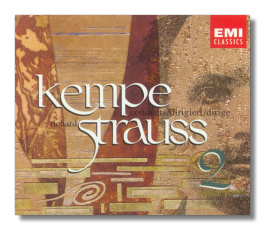
The Internet's Premier Classical Music Source
Related Links
-
Find CDs & Downloads
Amazon - UK - Germany - Canada - France - Japan
ArkivMusic - CD Universe
Find DVDs & Blu-ray
Amazon - UK - Germany - Canada - France - Japan
ArkivMusic-Video Universe
Find Scores & Sheet Music
Sheet Music Plus -
Search Amazon
Recommended Links
Site News
Richard Strauss
Annotated Discography
Also sprach Zarathustra, Op. 30
RCA Classics 09026-60929-2
Serge Koussevitzky/Boston Symphony Orchestra (1935)
A well-played, but not inspired account from the great conductor. The sound of this historic reissue, probably state of the art at the time, remains acceptable to all but those who insist on stereo. Koussevitzky does best in the "Convalescent" section and there brings real ferocity to the work. The Boston Symphony Orchestra plays with astonishing precision, rivaled at the time only by Mengelberg's Concertgebouw, but most of the interpretation impresses you as simply a good job.
RCA 09026-61494-2 or 09026-60930-2
Fritz Reiner/Chicago Symphony Orchestra (1954)
The first of Reiner's two stereo versions (1954, 1962), and generally considered the better. RCA habitually reissues their catalogue in new groupings. The RCA gives you Heldenleben. With the RCA, you get Der Burger als Edelmann Suite (more on this below) and waltzes from Rosenkavalier. The RCA recording succeeds on all levels. The Chicago not only delivers its patented "wall of sound," but it also gives you chamber-like playing of unbelievable delicacy and refinement, particularly in the 17-part divisi writing for the strings in the "Von der Hinterweltlern" sections and the bubbling of the "Tanzlied." In a score filled with traps, I find only one miscalculation: the great C-major climax of "The Convalescent," followed by silence, followed (ideally) by the sharp stab of a b-minor chord. Reiner's b-minor chord is flaccidly attacked. But this is a quibble with a superb reading. Reiner and Chicago roll on almost without letup. This is one of the few recordings that treats the piece as a symphonic construction, rather than as a movie theme with an inexplicably long half-hour addendum. You perceive the motific threads throughout the work. The "Science" fugue, for once, comes off as musically interesting rather than mud, and Reiner strongly ties it to the fury of the "Convalescent" section which follows. Thus, the interpretation is not merely the flawless performance of components, but proceeds in big stretches. Add to the reading the miracle of recorded sound, undated in forty years (still almost demonstration quality, in fact), and you have a classic recording of this very problematic work.
Sony SMK47626
Leonard Bernstein/New York Philharmonic (1970)
Beautifully remastered, this interpretation amounts to little more than a series of pretty sounds. Bernstein drags out everything, apparently under the impression that the tortoise is the wisest animal in the forest. His reading confirms those who view Zarathustra as portentous twaddle, although I suspect that they take Strauss' program more seriously than they take the music. You may indeed find the work's philosophic aspirations difficult to credit, but it certainly doesn't bore you, as here. Bernstein brings out so little detail in the "Science" fugue, that it sounds more like a chorale. The "Convalescent" should have been a great opportunity for Bernstein's famous electricity, but he misses it. The waltz comes off well, as concertmaster David Nadien crisply tosses off the difficulties of the part, but even here, the orchestra weighs in a bit heavily. The buildup to and the great strokes of the bell make their effect in the "Night Wanderer's Song," but the coda returns to the same old drag. Bernstein obviously attacks the work in sections. We see little evidence of Strauss' ability to think in long paragraphs.
EMI CMS764346-2
Rudolf Kempe/Dresden State Orchestra (1973)
Kempe interprets the work similarly to Reiner. About the only thing missing is the glorious sound of the Chicago Orchestra. On the other hand, if anything, Kempe's textures are even more transparent than Reiner's. The "Science" fugue in particular stands out. The C-major climax of "The Convalescent" and the subsequent b-minor stab are superbly handled, and in the subsequent development leading to the waltz, Kempe emphasizes like no one else the fantastic, almost Pétrouchkan side of Strauss' orchestration. The waltz itself percolates and sings with unmatched warmth. In fact, from the development through the coda, Kempe presents one huge, breathtaking symphonic paragraph – an interpretation in the Reiner class.
Deutsche Grammophon 439016-2
Herbert von Karajan/Berlin Philharmonic (1984)
A snoozer and, surprisingly, not all that well played. The ensemble is ragged, the textures murky. The interpretation is late-Karajan smooth. Nothing stands out, because everything sounds at the same level of intensity, just louder or softer, depending on the marking. The earlier, famous recording on London is not currently listed in Schwann Opus.
London 425942-2
Vladimir Ashkenazy/Cleveland Orchestra (1990)
The playing is superb, of course, because it's the Cleveland Orchestra, which, like Chicago, has a long and honorable history with the works of Strauss. However, the best I can say of Ashkenazy is that, unlike Bernstein, he makes no major mistakes, but only because, unlike Bernstein, he takes no major chances. The interpretation, okay without rising to inspired, seems merely dutiful. One looks fruitlessly for Reiner's grand march through or Kempe's magic. The Cleveland has made better Strauss recordings than this.
Copyright © 1994-2008 by Steve Schwartz & Classical Net. All Rights Reserved.














